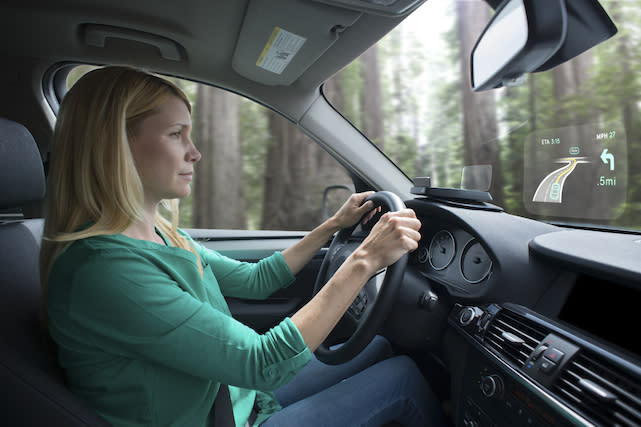Navdy gives your car an iPhone-linked HUD

We love our cars, and we love our iPhones, but sometimes we don't love them so much together. Navigation and entertainment apps provide a wonderful road trip experience, but controlling those apps by touch or by voice is tougher -- and more dangerous -- than it should be, even using clever clips to attach the phone to the car. There's a fundamental incompatibility between paying attention to a tiny touchscreen at arm's length and paying attention to large amounts of kinetic energy embodied in a massive chunk of steel and plastic moving at 100 km/h.
Apple's CarPlay shim for iPhone 5+ devices will address some of those command and control issues (if you buy a new car, or refit your stereo with an aftermarket unit) by relocating the functional display of the phone to the dashboard, reskinning the UI for simplicity, and enabling both physical switches and Siri-based voice controls for functional operations. That still doesn't clear the biggest hurdle: keeping your eyes on the road as you drive, rather than pulling your focus back to the center console and degrading your driving attention.
The limitations of in-dash or phone displays have led to some creative solutions like the HUDWAY directions app, Sygic's HUD feature in its nav app, Garmin's HUD (Head Up Display) unit and others. The app-only solutions are fine at night, but they suffer in the sunlight (not to mention lightly braising your phone as it sits on the dash). Garmin's LED-based unit is fine but inflexible, and only works with the company's nav apps.
The upcoming Navdy HUD, however, aims for more flexibility and a slick set of interaction modes combined with a full-featured, correctly distanced projection setup that makes it appear as though the display (driven by your iPhone or Android phone) is floating two meters away over the road ahead. Navdy can draw power and data from your car's diagnostic (OBD-II) port, which lets Navdy display speed and distance-to-empty while opening up the possibility of future features to analyze and manage driving and performance data. All this savvy will come at a price, however: Navdy's pre-order cost of US$299 (versus a regular retail price of $499 when it ships in early 2015) is 2x the Garmin unit's price, although Garmin's HUD only works if you buy one of the company's $30+ nav apps to drive it.
The Navdy unit, which will connect to the dash via a combined silicon friction mount and a magnetic interlock, will support nav apps like Google Maps and music apps like the built-in iTunes app, Pandora, Spotify and more. The UI of those apps is distilled down to create a "glanceable" experience, keeping only the critical information a driver needs and eliminating any excess chrome or distractions from the HUD. Even multitasking will be driver-friendly; any incoming call or SMS will only take over a part of the display, leaving speed and next turn visible at all times. Of course, SMS or iMessage alerts can be read aloud; with parental controls, they can be disabled entirely while the car is in motion.
The voice and gesture controls of Navdy take the HUD experience to the next level. Dictating messages or directions can be done with Siri natively, but Navdy adds a noise-cancelling mic directly in front of the driver's mouth to improve recognition performance. Gestures can accept or turn down an incoming call, change music tracks and more via left/right swipes and a thumbs-up. Navdy talks to your phone via Bluetooth, and since it uses the OBD port for power it won't clog up your 12v/cigarette lighter plug. For cars made before 1996, Navdy will offer an optional 12v adapter to use instead of the OBD connector.
The display quality, in the preproduction unit I examined, was very good. The "floating" effect is quite solid and there was no eyestrain or other sense of looking at something that wasn't really there. With a real-world placement on a hot dashboard in the bright sun, your mileage may vary, but Navdy's founders believe they can deliver HUD technology that will work for both everyday and performance drivers in any kind of driving conditions.
Both the discount and full-price Navdy may seem quite steep; it's tough to put $300 into a device that you haven't seen in action. But if the Navdy team can deliver on all the functionality they plan to package into the unit, my feeling is that it will be worth the cost.
You can read more about Navdy and place a pre-order at www.navdy.com. Navdy's launch video (produced by the delightful and talented Adam Lisagor) is embedded below.

